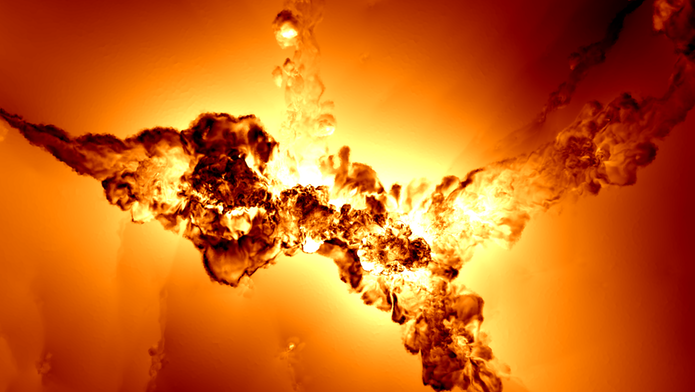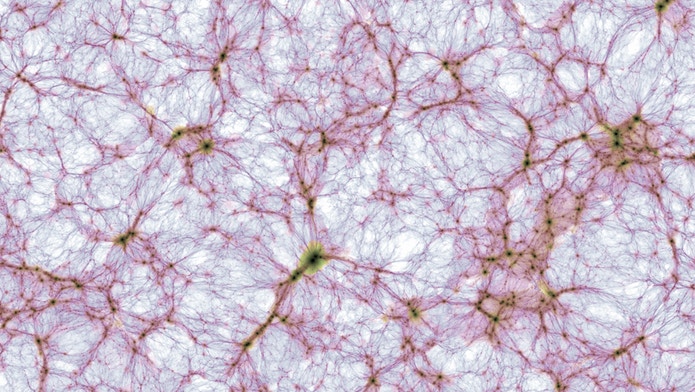Astrophysicists have just created the most advanced and detailed simulation of the Universe ever
Illustris: The Next Generation or IllustrisTNG will allow scientists to to not just view galaxies but also see their "entire formation history".



Our universe is vast and dynamic, a large portion of which is yet to be understood or possibly even discovered by humans. However, recent advancements in science and technology have allowed scientists to learn more about our ever-expanding universe. Now, a team of astrophysicists from Max Planck Institutes for Astronomy and Astrophysics, MIT, Harvard and the Flatiron Institute's Center for Computational Astrophysics (CCA) have created the most advanced and detailed simulation of the universe ever.
Titled Illustris: The Next Generation or IllustrisTNG, the new simulation will allow scientists to not only view galaxies but also see their "entire formation history". The simulation also provides new insight into how galaxies are formed, the origins of magnetic fields, how black holes influence dark matter distribution and more.
"When we observe galaxies using a telescope, we can only measure certain quantities," Shy Genel, an associate research scientist at CCA who helped develop and hone IllustrisTNG, said in a statement. "With the simulation, we can track all the properties for all these galaxies. And not just how the galaxy looks now, but its entire formation history."
According to Genel, mapping galaxies' evolution in the simulation also offers insight into what our very own Milky Way galaxy may have looked like when the Earth was formed and how our galaxy could change in the future.
IllustrisTNG is the successor to the Illustris model, also developed by the same research team. The new simulation has been updated to include some of the physical processes that play a primary role in the way galaxies are formed and their evolution. The simulation includes the formation of millions of galaxies, consisting of 18 simulations of various scales – each of which covers a cubic mock-up of space nearly 1 billion light years. In other words, the simulation is designed to track the evolution of the universe from The Big Bang, way into the future.
The simulations also help predict how the cosmic web of dark matter and gas evolves with time. "It is particularly fascinating that we can accurately predict the influence of supermassive black holes on the distribution of matter out to large scales," said Volker Springel at the Heidelberg Institute for Theoretical Studies. "This is crucial for reliably interpreting forthcoming cosmological measurements."
According to Mark Vogelsberger, an assistant professor of physics at MIT and the MIT Kavli Institute for Astrophysics and Space Research, the simulation can also help detect observable signals from large-scale magnetic fields.
"The high resolution of IllustrisTNG combined with its sophisticated galaxy formation model allowed us to explore these questions of magnetic fields in more detail than with any previous cosmological simulations," Vogelsberger said.
It took over 24,000 processors over two months to compute just one of the two main simulation runs. "The new simulations produced more than 500 terabytes of simulation data," says Springel. "Analyzing this huge mountain of data will keep us busy for years to come, and it promises many exciting new insights into different astrophysical processes."
IllustrisTNG's level of accuracy has already allowed researchers to publish three new research papers detailing the massive cluster of matter in the universe, which help better understand how galaxies are formed. One paper, published in the Monthly Notices of the Royal Astronomical Society, described the nature of faint stellar glow around stars, only theorised so far – however, IllustrisTNG was able to simulate the exact signs that astronomers should look for.
Another paper explored how black holes influence the formation of stars.
"The only physical entity capable of extinguishing the star formation in our large elliptical galaxies are the supermassive black holes at their centers," said Dylan Nelson, a researcher at the MPA. "The ultrafast outflows of these gravity traps reach velocities up to 10 percent of the speed of light and affect giant stellar systems that are billions of times larger than the comparably small black hole itself."






















